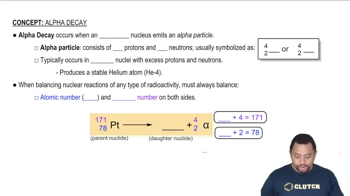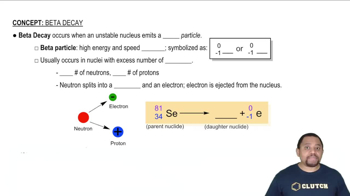Here are the essential concepts you must grasp in order to answer the question correctly.
Nuclear Decay
Nuclear decay is the process by which an unstable atomic nucleus loses energy by emitting radiation. This can occur in various forms, including alpha decay, beta decay, and gamma decay. In beta decay, a neutron in the nucleus is transformed into a proton, resulting in the emission of a beta particle (an electron or positron) and an increase in the atomic number of the element.
Recommended video:
Beta Decay
Beta decay is a specific type of nuclear decay where a beta particle is emitted from an atomic nucleus. In the case of beta-minus decay, a neutron is converted into a proton, increasing the atomic number by one while the mass number remains unchanged. This process transforms the original element into a different element, which is crucial for writing the nuclear equation.
Recommended video:
Nuclear Equations
Nuclear equations represent the transformation of one nuclide into another during radioactive decay. They are written in a specific format, showing the initial nuclide, the emitted particles, and the resulting nuclide. For beta decay, the equation will include the original nuclide, the emitted beta particle, and the new nuclide formed after the decay, ensuring that both mass and charge are conserved.
Recommended video:
 Verified step by step guidance
Verified step by step guidance


